 Ten or 20 years ago “planning your life’s career” meant just that. People tended to learn a relatively narrow set of skills and “settle in” to a professional life with a simple career path and one or two employers. Today this traditional employment model still exists but a current professional career might also involve multiple employment relationships participation in a “virtual” organization self-employment or pursuit of many types of jobs during one’s lifetime. The bottom line in today’s world is that it pays to be educated broadly yet skilled technically to meet the challenges and reap the tremendous opportunities of an information-based global economy. More and more this information-based global economy is becoming a geospatial information-based economy. Such tools as aerial and satellite remote sensing imagery the Global Positioning System (GPS) and computerized geographic information systems (GIS) are revolutionizing the conduct of business science and government alike.
Ten or 20 years ago “planning your life’s career” meant just that. People tended to learn a relatively narrow set of skills and “settle in” to a professional life with a simple career path and one or two employers. Today this traditional employment model still exists but a current professional career might also involve multiple employment relationships participation in a “virtual” organization self-employment or pursuit of many types of jobs during one’s lifetime. The bottom line in today’s world is that it pays to be educated broadly yet skilled technically to meet the challenges and reap the tremendous opportunities of an information-based global economy. More and more this information-based global economy is becoming a geospatial information-based economy. Such tools as aerial and satellite remote sensing imagery the Global Positioning System (GPS) and computerized geographic information systems (GIS) are revolutionizing the conduct of business science and government alike.
Geospatial information is increasingly becoming the driving force for decision making across the local to global continuum. Tasks as varied as planning urban growth managing a forest implementing “precision farming,” assessing insurance claims siting an automatic teller machine routing 911 vehicles drilling a well assessing groundwater contamination designing a cellular phone network guiding “intelligent” vehicles assessing the market for manufactured goods managing a city operating a utility improving wildlife habitat monitoring air quality assessing environmental impact designing a road studying human health statistics minimizing water pollution undertaking real estate transactions preserving wetlands mapping natural hazards and disasters providing famine relief or studying the causes and consequences of global climate change can be greatly enhanced by the use of some form of geospatial technology. The pioneers builders and specialists in geospatial information collection and management are trained in such fields as photogrammetry remote sensing and GIS.
Photogrammetry
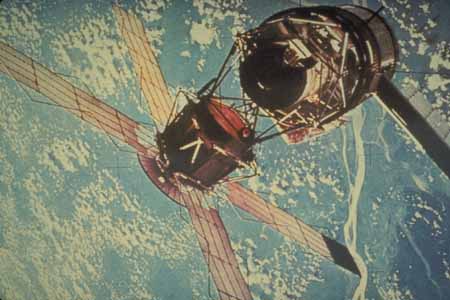 |
Photogrammetry is the tongue-twisting term for the science and technology of obtaining reliable measurements maps digital elevation models and other GIS data primarily from aerial and space photography. Professional photogrammetrists are responsible for all phases of mapping projects and provide spatially accurate base maps that form a foundation for many applications of GIS. Functions can include planning and supervising ground and aerial surveys interpreting and making measurements from remote sensing imagery designing maps and cartographic presentations reproduction and distribution of map products and managing general business and organizational aspects of photogrammetric projects. |
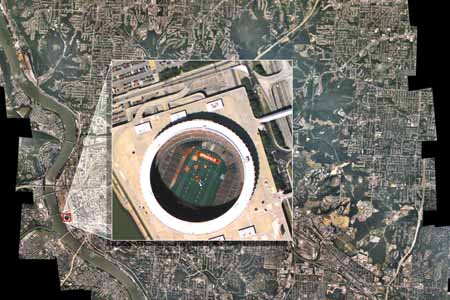 Many engineering disciplines also use photogrammetric data as the basis for project planning and design. In order to serve these customers effectively the professional photogrammetrist must have a broad understanding of a number of civil engineering and GIS disciplines as well as surveying and geodesy (the study of the true shape of the earth). Some photogrammetrists are employed in the design and manufacturing of specialized data acquisition analysis and measurement equipment.As we move into the 21st century the photogrammetrist must be well versed in mapping from a variety of source data types: conventional and digital aerial photography satellite imagery laser ranging (lidar) and radar to name a few. As a provider of data to a wide variety of users the photogrammetrist will make professional assessments of the spatial accuracy and integrity of these widely varied data types and will make recommendations for the application of these data in engineering and GIS analysis. Many engineering disciplines also use photogrammetric data as the basis for project planning and design. In order to serve these customers effectively the professional photogrammetrist must have a broad understanding of a number of civil engineering and GIS disciplines as well as surveying and geodesy (the study of the true shape of the earth). Some photogrammetrists are employed in the design and manufacturing of specialized data acquisition analysis and measurement equipment.As we move into the 21st century the photogrammetrist must be well versed in mapping from a variety of source data types: conventional and digital aerial photography satellite imagery laser ranging (lidar) and radar to name a few. As a provider of data to a wide variety of users the photogrammetrist will make professional assessments of the spatial accuracy and integrity of these widely varied data types and will make recommendations for the application of these data in engineering and GIS analysis. |
|
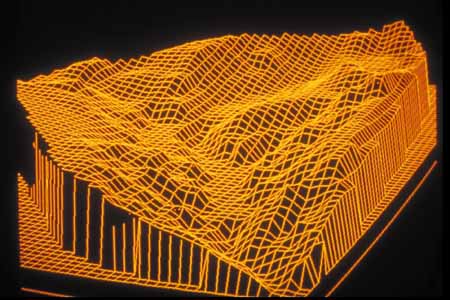
Remote Sensing
In a nutshell remote sensing refers to any technique whereby information about objects and the environment is obtained from a distance. A bat’s navigation system is one form of remote sensing. In this case acoustic waves are used to “see” objects and determine their position. Remote sensing in the context of obtaining geospatial information is based on measuring variations in how electromagnetic waves interact with objects. The wavelengths typically involved not only include visible light but also near-infrared mid-infrared thermal and microwave energy. Hence remote sensing systems often permit us to greatly expand our spectral view of the earth and “see” the world much more clearly than we can with the unaided eye or any other sensor restricted to visible wavelengths.
 Today an extremely broad range of remote sensing systems are used to collect data from both aerial and spaceborne platforms. These systems include everything from aerial cameras to earth orbiting multispectral sensors and imaging radar systems. Remote sensing like photogrammetry and GIS is a rapidly changing field. Three recent developments in particular are fueling great interest and activity in the field. First there is substantial research and development underway in the area of hyperspectral remote sensing which involves systems that sense in literally hundreds of very narrow spectral bands simultaneously. This approach greatly increases the information and detail that can be obtained about objects on the earth’s surface. Second a series of recently launched satellite-borne remote sensing systems form NASA’s Earth Observing System (EOS) which is a primary component of the Earth Science Enterprise (ESE). The ESE is an international earth science program aimed at proving the observations understanding and modeling capabilities needed to assess the impacts of both natural events and human-induced activities on the earth’s environment (www.earth.nasa.gov/).
Today an extremely broad range of remote sensing systems are used to collect data from both aerial and spaceborne platforms. These systems include everything from aerial cameras to earth orbiting multispectral sensors and imaging radar systems. Remote sensing like photogrammetry and GIS is a rapidly changing field. Three recent developments in particular are fueling great interest and activity in the field. First there is substantial research and development underway in the area of hyperspectral remote sensing which involves systems that sense in literally hundreds of very narrow spectral bands simultaneously. This approach greatly increases the information and detail that can be obtained about objects on the earth’s surface. Second a series of recently launched satellite-borne remote sensing systems form NASA’s Earth Observing System (EOS) which is a primary component of the Earth Science Enterprise (ESE). The ESE is an international earth science program aimed at proving the observations understanding and modeling capabilities needed to assess the impacts of both natural events and human-induced activities on the earth’s environment (www.earth.nasa.gov/).
A third major influence on the field of remote sensing today is the launch of commercial high-resolution earth-orbiting systems. These systems supply data with a ground sampling distance on the order of 1 meter (3 feet). This will permit objects of approximately one meter in length to be identified on the earth’s surface using a satellite in outer space. Most will also be pointable with their optical systems being controlled by ground command. This will enable frequent observation of areas that are not directly below the satellite and it will also allow the collection of stereoscopic (3D) data. These high-resolution systems are expected to provide a quantum jump in the commercial applications of remote sensing and hence the demand for professionals in the field. In all some 45 new satellite remote sensing systems are planned for launch over the next three years (www.ersc.wisc.edu/ersc/).
http://hosthp.com/images/stories/july99.jpg
Remote sensing is a very broadly based field. Professionals with backgrounds in such diverse areas as agriculture archaeology business ecology engineering forestry geography geology range management urban and regional planning water resources wetland ecology wildlife management manufacturing and machine vision meteorology and oceanography use the information processed from remotely sensing data. In addition many remote sensing scientists are involved in basic research developing new sensor systems other instruments and defining new analytical techniques. Many such people are also actively engaged in the area of digital image processing which is changing rapidly with major improvements in the power of computer systems networks and visualization techniques.
Geographic Information Systems
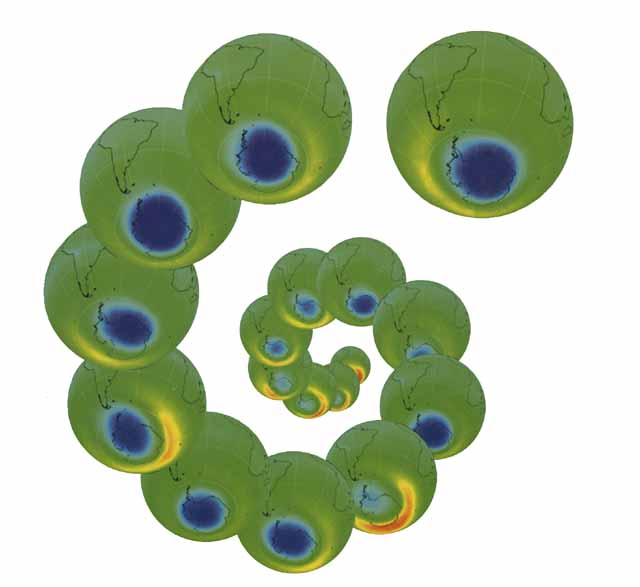 Geographic Information Systems (GIS) are computerized systems that allow the user to work with interrelate and analyze virtually all forms of spatial data. Typically a GIS consists of three major components: a database of geospatial and thematic data and information a capability to spatially model or analyze the data sets and a graphical display capability. A GIS synthesizes computer mapping and automated cartography spatial analysis data modeling and database management into a coherent unit. GIS enables the combining (overlay) and analysis of various geographically-based data sets for use in many decision making processes that benefit from the ability to visualize data and information in different ways.
Geographic Information Systems (GIS) are computerized systems that allow the user to work with interrelate and analyze virtually all forms of spatial data. Typically a GIS consists of three major components: a database of geospatial and thematic data and information a capability to spatially model or analyze the data sets and a graphical display capability. A GIS synthesizes computer mapping and automated cartography spatial analysis data modeling and database management into a coherent unit. GIS enables the combining (overlay) and analysis of various geographically-based data sets for use in many decision making processes that benefit from the ability to visualize data and information in different ways.
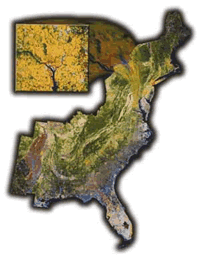
GIS emerged as a viable technology in the early 1980s. In the 1990s it exploded into one of the fastest growing and most widely adopted technologies in the information age. GIS technology also crosscuts many disciplines and applications ranging from the medical profession to natural resource management. Likewise it spans a diverse group of user communities ranging from small villages to Federal agencies. This exciting technological development integrates remotely sensed and ground-based information into powerful decision making analytical tools. Knowledge and experience is often desirable in one or several application areas such as biology/ecology resource management facilities management planning or engineering.
| Geographic information systems are used to provide information and knowledge data in various forms to help resolve complex resource questions such as: |
|
|
|
|
|
| Geographic information systems are also enjoying greatly expanded application in business_from siting retail stores to real estate logistics and marketing. Together photogrammetry remote sensing and GIS offer numerous employment opportunities throughout the private governmental and academic sectors and across the globe. |
Educational Background
Requirements/ SuggestionsHigh School – College-preparatory courses that emphasize the sciences are suggested for individuals interested in pursuing careers in photogrammetry remote sensing and GIS. Examples include but are not limited to mathematics (algebra trigonometry geometry calculus) biology chemistry physics geography earth science computer programming and applications drafting English fine arts/humanities social studies and foreign languages. Community Colleges and Technical Institutions – Many 2-year academic and technical institutions offer education and training in photogrammetry remote sensing and GIS and in related fields. Associate degree and certificate programs in GIS surveying photogrammetry and similar curricula provide a sound foundation for work experience or for transfer to other academic institutions for further education. There is a substantial demand for technicians in geospatial information technology for individuals who do not wish to pursue an advanced degree. |
 |
| Colleges and Universities – Majors emphasizing photogrammetry remote sensing and GIS are typically found in geography geomatics engineering civil engineering forestry planning surveying and mapping or various physical science programs at many colleges and universities and can result in earning bachelor’s master’s and doctoral degrees. Increasingly colleges and universities are offering minors certificates and specialized professional master’s degree programs in these areas as well. Hence educational preparation can be targeted either toward becoming a specialist in the field of geospatial information science and technology or a specialist in a traditional discipline with a complementary background in photogrammetry remote sensing and GIS.
Internships – It is highly recommended that any individual wishing to pursue a career in photogrammetry remote sensing and GIS participate in an internship program to obtain “hands-on” experience as part of their preparation for employment. Such opportunities are plentiful for those having at least introductory knowledge about geospatial information science and technology. Continuing Education – Like many rapidly advancing high-tech fields continuing education in photogrammetry remote sensing and GIS is a must to keep current as a professional. ASPRS: The Imaging & Geospatial Information Society other professional and scientific organizations hardware and software providers and educational institutions offer programs fulfilling this need. Photogrammetry – To qualify as a professional photogrammetrist you generally need a bachelor’s degree or significant work experience combined with a two-year technical degree in disciplines such as surveying engineering cartography or geodesy. While this education generally occurs in engineering curricula it can also be found in some geography forestry or resource management programs. Photogrammetry is a professional discipline newly recognized by the National Council of Examiners for Engineering and Surveying (NCEES). In an increasing number of states it is possible to attain professional status and licensure as a photogrammetric surveyor or mapper. Remote Sensing – A bachelor’s or graduate degree is usually required for professional status. Such fields as engineering physical geography mathematics statistics computer science and the biological and physical sciences all provide good training for remote sensing. A highly interdisciplinary education often serves as a good foundation for professional work in this field. GIS – Most professionals involved in the GIS field receive an education in the earth sciences engineering management or planning; supplemented with courses in traditional and automated cartography mapping and remote sensing spatial statistics computer science mathematics and GIS fundamentals and applications. Where will I find a school that offers these courses? For a sampling of colleges and universities offering programs in GIS remote sensing or photogrammetry see the web sites for the University Consortium for Geographic Information Science (www.ucgis.org). The Accreditation Board for Engineering and Technology (ABET) evaluates university and college degree programs in surveying engineering and technology some of which include imaging and geospatial information discipline areas. Visit their website (www.abet.org) and go to the link on accredited programs for listings of colleges and universities and their ASPRS-related programs. Course catalogs for these institutions will define specific courses for these degree programs. |
|
| Careers in the Geospatial Sciences |
| Computer Science |
 |
EmploymentAs mentioned previously careers in imaging and geospatial technology disciplines are available in nearly all segments of the commercial public government and academic communities. Job titles and starting salaries vary with experience and background. Geographer cartographer physical scientist computer scientist GIS analyst database administrator applications specialist project manager remote sensing scientist surveyor photogrammetrist and image analyst are typical job titles. Detailed information on potential employers in the private sector is available in the special annual issue of Photogrammetric Engineering & Remote Sensing – Resource Book as well as at the ASPRS web site (www.asprs.org). The Resource Book lists names and addresses of companies who are Sustaining Members of ASPRS along with a description of their products and services.State and local government agencies offer opportunities in ASPRS discipline areas. State government activity in these disciplines are generally carried out in agencies such as planning environment resources transportation and geology and are usually coordinated through state geographic information councils. The National States Geographic Information Council (NSGIC) which serves as the national coordinating body for these state organizations can be contacted through links at the NSGIC website (www.nsgic.org). Employment opportunities in city and county government agencies often parallel state job titles and positions and can be researched at their respective city or county employment offices. Academic institution offerings at the entry level are usually for graduate students at those institutions for teaching assistant or other staff support positions although instructor positions become available and are widely advertised. World Wide Web searches keyed on locality names and employment yield connections to these opportunities. Many U.S. government agencies such as the U.S. Geological Survey (USGS) National Oceanic and Atmospheric Administration (NOAA) U.S. Forest Service (USFS) Environmental Protection Agency (EPA) National Aeronautics and Space Administration (NASA) National Imagery and Mapping Agency (NIMA) and U.S. Bureau of Land Management (BLM) offer Federal employment opportunities in related fields. Job announcements and general descriptions of Federal employment opportunities and salary ranges can be found at the U.S. Office of Personnel Management’s (OPM) website (https://www.usajobs.gov/). With the increased use of computers in imaging and geospatial technology careers most jobs are in an office environment. However certain careers may require extensive field work to verify results or to acquire data in the outdoors. In addition imaging and geospatial technology disciplines are finding their way into many other applications and careers that are not traditionally associated with photogrammetry remote sensing and GIS. For example photogrammetry is being used in biomedical research GIS is finding broader use in real estate development and remote sensing/image processing are being used in law enforcement. Therefore job titles alone are not necessarily the best indication of career opportunities utilizing imaging and geospatial technology. An increasing number of graduates are utilizing GIS in private firms in environmental management planning and other businesses that require spatial analysis. The rise of many more commercial remote sensing firms also is a good opportunity for people with training in geospatial fields. With a bachelor’s degree an employee can expect to obtain an entry-level position working as part of a larger group. With experience employees can expect to be given more complex responsibilities and will begin to manage larger projects. Those with master’s degrees are often expected to assume considerable responsibility as soon as they are hired including their own projects to manage. In some smaller organizations employees may be expected to design and implement new imaging and geospatial information procedures and systems. Again substantial demand exists for technicians in this area to support such activities. For those who earn a doctoral degree (PhD) you could expect to find employment in a university or as a research scientist. The rapid growth of GIS programs at the university level has resulted in a growing market for PhD graduates. There is also a high demand for such individuals with consulting firms software development firms and scientific laboratories. Those employers expect you to make significant new contributions to the advancement of current technology develop new ways to analyze information or contribute to scientific research theory and discoveries Career GoalsMany things lead to a fulfilling career. Monetary reward ongoing technical challenge opportunity for advancement employment flexibility the development of a local to global perspective and the satisfaction of truly making a difference all characterize careers in this field. Geospatial information science and technology can provide many commercial scientific and social benefits in a broad range of settings. That’s why we like to say that when you enter this career area you not only shape your future but the future. Check out these web sites for job openings:
|
ASPRS: The Imaging & Geospatial Information Society
 ASPRS is a membership society that represents the interests of individuals and companies in the field of imaging and geospatial information. The mission of ASPRS is to advance knowledge and improve understanding of geospatial information science and technology and to promote the responsible application of photogrammetry remote sensing geographic information systems and supporting technologies.
ASPRS is a membership society that represents the interests of individuals and companies in the field of imaging and geospatial information. The mission of ASPRS is to advance knowledge and improve understanding of geospatial information science and technology and to promote the responsible application of photogrammetry remote sensing geographic information systems and supporting technologies.
Geospatial information answers the questions who what when and primarily where. ASPRS is committed to providing the highest quality spatial information to all people for effective decision making and better understanding to improve their quality of life.
Founded in 1934 ASPRS has given increasing service to the scientific user communities and the nation through development of the art and science of photogrammetry remote sensing and geographic information systems.
Scope of Society Interest
The core technologies represented by ASPRS are photogrammetry remote sensing and geographic information systems (GIS). Supporting technologies include but are not limited to cartography spatial positioning image processing and photo interpretation.
The Society’s integration of core and supporting technologies to real-world applications are currently concentrated in the areas of mapping environmental and natural resources modeling simulation visualization close-range imaging and sociocultural applications. The Society advances responsible practice through its professional certification program continuing education and workshops publications standards and venues for social and career networking.
To find out more about ASPRS and to become a member visit our web site at https://www.asprs.org.
Photo Credits
|
![]()


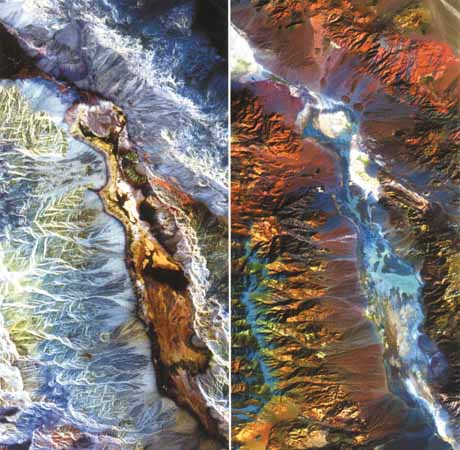 This image is a comparison of Landsat Thematic Mapper data on the right and a multipolarization multifrequency Shuttle Imaging Radar-C (SIR-C) image on the left. The image is of Death Valley National Park California USA. Provided by Reasearch Systems Inc.
This image is a comparison of Landsat Thematic Mapper data on the right and a multipolarization multifrequency Shuttle Imaging Radar-C (SIR-C) image on the left. The image is of Death Valley National Park California USA. Provided by Reasearch Systems Inc. This image was generated from NASA’s Total Ozone Mapping Spectrometer (TOMS) and illustrates the October mean total ozone from 1979-1994 and 1996. Provided by NASA’s Goddard Space Flight Center.
This image was generated from NASA’s Total Ozone Mapping Spectrometer (TOMS) and illustrates the October mean total ozone from 1979-1994 and 1996. Provided by NASA’s Goddard Space Flight Center. This image is a color infrared digital orthophoto quadrangle (DOQ) image of Imperial Beach California and Tijuana Mexico. Provided by the U.S. Geological Survey (USGS).
This image is a color infrared digital orthophoto quadrangle (DOQ) image of Imperial Beach California and Tijuana Mexico. Provided by the U.S. Geological Survey (USGS).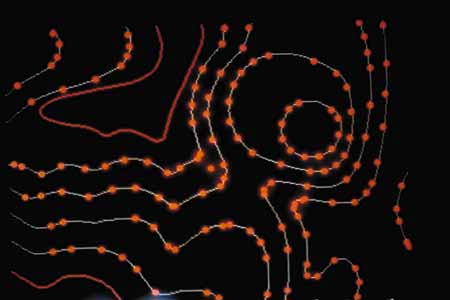 This image depicts data points on contours (lines of equal elevation on the Earth’s surface) in a digital elevation data set. Provided by the U.S. Geological Survey (USGS).
This image depicts data points on contours (lines of equal elevation on the Earth’s surface) in a digital elevation data set. Provided by the U.S. Geological Survey (USGS).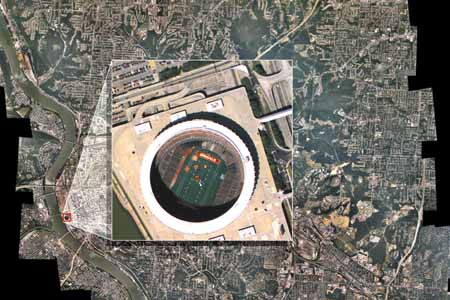 This image is a GSD natural color collection of the City of Cincinnati taken by Litton/TASC’s Emerge Digital Airborne Sensor System.
This image is a GSD natural color collection of the City of Cincinnati taken by Litton/TASC’s Emerge Digital Airborne Sensor System. This image is a rendering of 224-band Airborne Visible/Infrared Imaging Spectrometer (AVIRIS) hyperspectral data acquired by the Jet Propulsion Laboratory in the northwest corner of Yellowstone National Park. Provided by Research Systems Inc.
This image is a rendering of 224-band Airborne Visible/Infrared Imaging Spectrometer (AVIRIS) hyperspectral data acquired by the Jet Propulsion Laboratory in the northwest corner of Yellowstone National Park. Provided by Research Systems Inc.